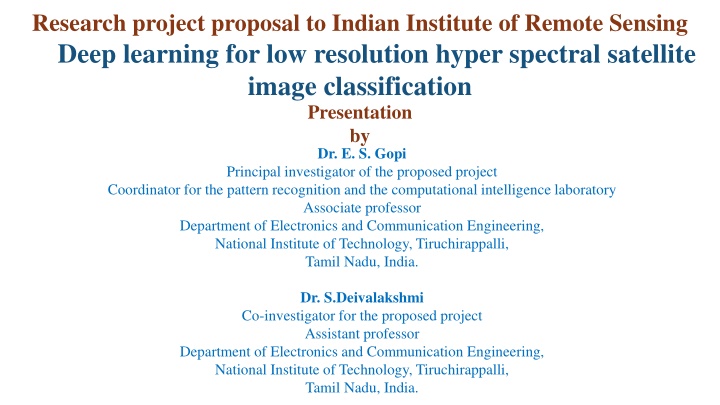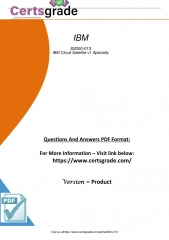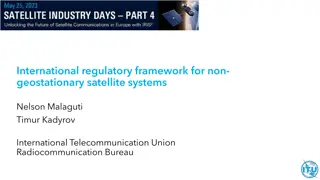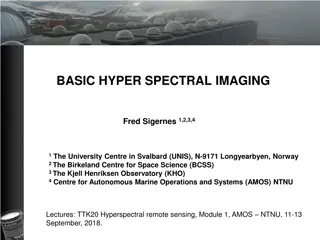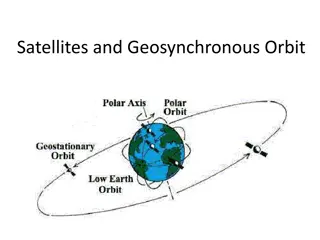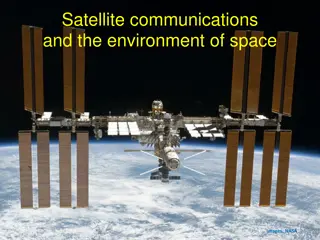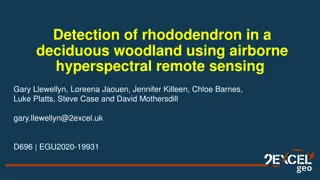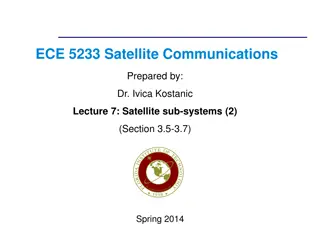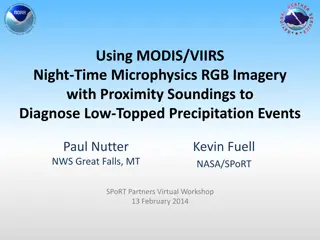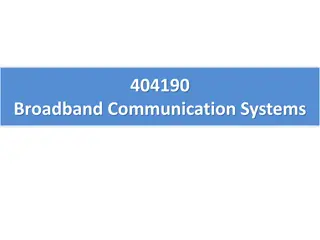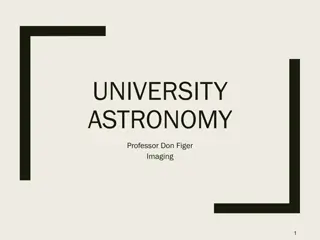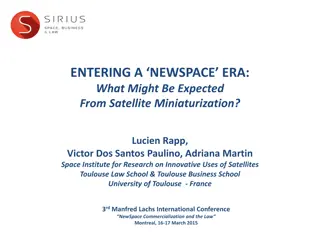Deep Learning for Low-Resolution Hyperspectral Satellite Image Classification
Dr. E. S. Gopi and Dr. S. Deivalakshmi propose a project at the Indian Institute of Remote Sensing to use Generative Adversarial Networks (GAN) for converting low-resolution hyperspectral images into high-resolution ones and developing a classifier for pixel-wise classification. The aim is to achieve effective classification with cost-effective low-resolution images compared to high-resolution ones. The project emphasizes the potential of GAN in various applications and the importance of hyperspectral image classification.
Download Presentation

Please find below an Image/Link to download the presentation.
The content on the website is provided AS IS for your information and personal use only. It may not be sold, licensed, or shared on other websites without obtaining consent from the author.If you encounter any issues during the download, it is possible that the publisher has removed the file from their server.
You are allowed to download the files provided on this website for personal or commercial use, subject to the condition that they are used lawfully. All files are the property of their respective owners.
The content on the website is provided AS IS for your information and personal use only. It may not be sold, licensed, or shared on other websites without obtaining consent from the author.
E N D
Presentation Transcript
Research project proposal to Indian Institute of Remote Sensing Deep learning for low resolution hyper spectral satellite image classification Presentation by Dr. E. S. Gopi Principal investigator of the proposed project Coordinator for the pattern recognition and the computational intelligence laboratory Associate professor Department of Electronics and Communication Engineering, National Institute of Technology, Tiruchirappalli, Tamil Nadu, India. Dr. S.Deivalakshmi Co-investigator for the proposed project Assistant professor Department of Electronics and Communication Engineering, National Institute of Technology, Tiruchirappalli, Tamil Nadu, India.
Objectives To demonstrate the developed algorithm to convert the low resolution hyper spectral images into high resolution hyper spectral images using GAN. To construct the classifier to classify the pixels of the high resolution images (obtained from the trained GAN) into finite number of classes and to compare the performance of the classifier with the corresponding actual high resolution images. Importance: The Hyper spectral images captured with high resolution is expensive. In our proposal, we suggest to use the cost effective low resolution hyper spectral Images for the pixel wise supervised classification that performs at par with the one using high resolution Images using GAN (Generative Adversarial Network).
Proposed Idea 1. GAN was introduced during 2014 (by Ian Good fellow) that was actually developed to generate photographs. But in recent years, GAN is being used in many applications like converting MRI to the corresponding CT image, Thermal image to the corresponding visible image, low resolution to high resolution image conversion , etc. 2. There are attempts made on GAN based Hyper spectral image classification. In this technique, GAN is used to obtain the class label of the individual pixel of the hyper spectral images directly (without increasing the resolution of the image). 3.7 m x 3.7 m per pixel.
Proposed Idea (Contn) 3. In our proposal, it is planned to use the low resolution hyper spectral images for classification 4. It is proposed to use GAN network to convert the low resolution hyper spectral images into high resolution hyper spectral images. 5. The obtained high resolution images are subjected for further classification. Mainly in our proposed approach, we can increase the spatial resolution of the hyper spectral images that were taken with low resolution.
Generative Adversarial Network (GAN) Discriminator 1. The Discriminator is the two class classifier. 2. The sample outcome from the random variable with pdf ????? is treated as the one belongs to the class 1. 3. The sample outcome from the random variable with pdf ?? is treated as the one belongs to the class 2 . 4. The output of the discriminator is the probability that the input (I) belongs to the class 1 i.e. D(I, )=p(class1/I). 5. Note that ?? belongs to class 1 and G(??, ) belongs to class2. Given ??and G(??, ) (i.e.) is fixed, is optimized by maximizing the following likelihood function. Max: arg
Generator 1. Objective is to generate ?? outcome ?? (with pdf ?????) from ?? (with pdf ??) . 2. Initially Generator generates ?? (with pdf ??) and we would like the generator to generate ?? with ??=?????. This implies, we would like to optimize in such a way that the Discriminator D treats the G(??, ) to be the one belongs to class 1. 3. This implies Max: arg Min: arg
Training GAN 1. It can be shown that given , optimal is obtained when ?????(?) ?????(?)+??(?) D I = where I is the input to the discriminator (?????? or G(??, )). 2. Given , the optimal is obtained when ?????(?)=??(?)and hence convergence is attained when ? ? =1 2.
Recent approach 1: Hyperspectral Image classification using GAN* Lin Zhu, Yushi Chen Pedram Ghamisi and Jon Atli Benediktsson, Generative Adversarial Networks for Hyperspectral Image Classification , IEEE Transactions on Geo science and Remote sensing, 2018, 56(9), pp. 5046-5063. Typical dataset: Salinas (Airborne visible/infrared imaging spectrometer) with the resolution of 3.7 m x 3.7 m per pixel and 16 classes of interest (Brocoli_green_weeds_1, Brocoli_green_weeds_2, Vinyard_vertical_trellis).
Recent approach 1: Hyperspectral Image classification using GAN Discriminator (Lc+Ls) Generator (Lc-Ls)
Recent approach 2: Hyperspectral Image classification using GAN
Recent approach 2: Hyperspectral Image classification using GAN Note: In this case, the complete 64x64 is classified as the one belonging to the particular class
Our proposed approach based on the paper* * Christian Ledig et.al., Photo-Realistic Single Image Super Resolution Using a Generative Adversarial Network , 2017 lEEE Conference on Computer Vision and Pattern recognition. : Generator is trained to minimize perceptual loss function [1]Content loss (a) MSE loss and/or (b) Euclidean distance between the feature representation of the reconstructed image and the reference image [2]Adversarial loss: Discriminator tries to maximize Max: arg
Outline of the proposed technique In Generative Adversarial Network, we have two convolution network structures. One acts as the generator block and the other as the discriminator block. Group of hyper spectral images (Sublocks) are given as the input to the generator block. The generator block tries to convert the group of low resolution images into group of corresponding high resolution images. The generated high resolution images, along with the corresponding actual high resolution images are given as the input to the discriminator.
Outline of the proposed technique (Contn) The discriminator network is trained such that the variable associated with the output of the discriminator takes the value 0.5 (for the ideal cases) for both original high resolution image and the high resolution image obtained from the generator. This is done to make sure that the discriminator is not able to discriminate the original high resolution image and the one generated by the generator. The high resolution image (corresponding to the low resolution image under test) is obtained using the trained generator and are subjected to the classification using the classifier like Support Vector Machine. This approach has the advantage of making use of correlation between different spectral bands during training phase. As batch processing is involved during the training phase, slow convergence is expected.
Outline of the proposed technique (Contn) Alternative approach Instead of using single GAN, 220 different GANs (one for each spectral band) is considered. Upon training, classification is done by combining the decision taken by the individual trained GAN. As the complexity of the individual GAN is limited, we expect fast convergence in this approach.
Expertise of the principle Investigator Name: Dr. E.S. Gopi, Co-ordinator for the pattern recognition and the computational intelligence laboratory Associate professor, Electronics and Communication Engineering, National Institute of Technology, Tiruchirappalli. Area of interest: Pattern recognition, Computational intelligence, Signal processing Relevant (Books): Selective journal publications: [1] G.Jayabrindha, E.S.Gopi, "Ant Colony Technique for Optimizing the Order of Cascaded SVM Classifier for Sunflower Seed Classification" , IEEE Transactions on Emerging Topics in Computational Intelligence,pp.78 - 88, Vol.2, Issue 1, 2017. [2] E.S.Gopi, "Digital image forgery detection using artificial neural network and independent component analysis", Elsevier journal on Applied Mathematics and Computation (Impact factor:1.738) ,Vol. 194-2, 2007, pp. 540-543. ISSN:0096-3003 [3] E.S.Gopi, P.Palanisamy "Neural network based class-conditional probability density function using kernel trick for supervised classifier", Elsevier journal on neuro computing (Impact factor:3.317), Vol.154, pp. 225-229, 2014, ISSN:0925-2312 [4] E.S.Gopi,P.Palanisamy, "Maximizing Gaussianity using kurtosis measurement in the kernel space for kernel linear discriminant analysis", Elsevier journal on neuro computing (Impact factor:3.317),Vol.144, pp.329-337, 2014, ISSN:0925-2312 [5] E.S.Gopi, P.Palanisamy "Formulating particle swarm optimization based membership linear discriminant analysis", Elsevier journal on swarm intelligence and evolutionary computation (Impact factor:3.893) , Vol.12, pp.65-73, 2013, ISSN:2210-6502 [6] E.S.Gopi, P.Palanisamy, "Fast computation of PCA bases of image subspace using its inner-product subspace", Elsevier journal on Applied Mathematics and Computation (Impact factor:1.738), Vol.219-12, pp.6729-6732, 2013, ISSN:0096-3003
Other reviewed Book chapters and conference publications: [1] Florintina.C, E.S.Gopi, "Music composition inspired by sea wave patterns observed from beaches", Proceedings of the 2nd International Conference on Data Engineering and Communication Technology (ICDECT 2017), Springer,2018. [2] Kshitij Rachchh, E.S.Gopi, "Inclusion of Vertical bar in the OMR sheet for Image Based Robust and Fast OMR Evaluation Technique using Mobile Phone Camera ",Proceedings of the 2nd International Conference on Data Engineering and Communication Technology (ICDECT 2017), Springer, 2018 [3] Vineetha Yogesh, E.S.Gopi, Shaik Mahammad, "Particle Swarm Optimization based HMM parameter estimation for spectrum sensing in Cognitive radio system", Edited volume on Computational intelligence for Pattern Recognition, Springer, 2018. [4] C. Florintina, E.S.Gopi, "Constructing a Linear Discrete System in Kernel Space as a Supervised Classifier",- Wispnet 2017, Chennai, 22- 24 March 2017. [5] Jay.K.Patel and E.S.Gopi, Musical Notes identification using Digital signal processing , Elsevier journal on procedia computer science (Cite score: 1.03) , Volume 57, 2015, Pages 876 884 [6] Hari Babu Padarthi and E.S.Gopi, Medical data classifications using Genetic algorithm based Generalized Kernel Linear Discriminant analysis , Elsevier journal on procedia computer science (Cite score:1.03), Volume 57, 2015, Pages 868 875 [7] E.S.Gopi, P.Palanisamy, "Scatter Matrix versus the Proposed Distance Matrix on Linear Discriminant Analysis for Image Pattern Recognition", Springer, pp.101-108, 2014 [8] Hemant Sharma and E.S. Gopi. "Signal processing approach for music synthesis using bird s Sounds", Elsevier journal on Procedia Technology , Volume 10, 2013, Pages 287-294 [9] Vinoth S and E S Gopi. Neural network modeling of color array filter for digital forgery detection using kernel LDA , Elsevier journal on Procedia Technology , Volume 10, 2013, Pages 287-294 [10] E.S.Gopi, P.Palanisamy, "Formulating Particle Swarm Optimization based Generalized Kernel Function for Kernel-Linear Discriminant Analysis", Elsevier journal on Proceedia technology, Vol.6, pp.517-525, 2013 [11] E.S.Gopi, R.Lakshmi, N.Ramya, and S.M. Shereen Farzana, "Music indexing using Independent Component Analysis with pseudo- generated sources,Independent Component Analysis and Blind Signal Separation", Springer Berlin Heidelberg,pp.1237-1244, 2004
Expertise of the Co-Investigator Name: Dr. S. Deivalakshmi, Assistant professor, Electronics and Communication Engineering, National Institute of Technology, Tiruchirappalli. Current Research Areas of interest: Image denoising and Enhancement techniques, Image superresolution and classification using deep learning, classification of hyper spectral images. R& D Projects Handled Co- Investigator for the DRDL, Hyderabad project titled Multiresolution Algorithm for image denoising and edge enhancement for CT images using discrete wavelet transforms with total funding of Rs.586000/- during the period 2004-2006. Selective journal publications: 1. S. Arivazhagan, Dr. L. Ganeshan , S. Deivalakshmi, Texture Classification Using Wavelet Statistical features , Institute of Engineers IE (I), Vol .85, pp. 51-55, Jan 2005. 2. S. Deivalakshmi, P. Palanisamy, Removal of High Density Salt and Pepper Noise through Improved Tolerance based Selective Arithmetic Mean Filtering with Wavelet Thresholding , Elsevier AEU International Journal of Electronics and Communications Engineering,70(6), pp.757-776, 2016. 3. S. Deivalakshmi, P. Palanisamy and X. Z. Gao, Balanced GHM Multiwavelet Transform based Contrast Enhancement Technology for Dark Images using Dynamic Stochastic Resonance , Taylor and Francis journal on Intelligent Automation And Soft Computing, 2017, Vol. XX, no. X, 1 5. 4. S. Arivazhagan, S. Deivalakshmi, K. Kannan, B. N. Gajbhiye, C. Muralidhar, Sijo N. Lukose,M. P. Subramanian, "Multi-Resolution System for Artifact Removal and Edge Enhancement in Computerized Tomography Images", Elsevier Journal on Pattern Recognition Letters, Vol. 28, Issue 13, pp.1769-1780, 1 October 2007.
International conference publications: 1. S. Arivazhagan, S. Deivalakshmi, K. Kannan, B.N.Gajbhiye, C.Muralidhar, Sijo N Lukose, M.P.Subramanian "Performance Analysis of Image Denoising System for Different Thresholding Techniques", IEEE International Conference on Signal and Image Processing (ICSIP, 06), pp. 666 - 670, Dec, 2006. 2. S. Deivalakshmi,"Moment Preserving Data Hiding ", International Conference on Intelligent Systems & Control (ISCO 2006), pp.145-148, Aug, 2006. 3. S. Deivalakshmi , P. Palanisamy, Sunil Sriramoju, Presented a paper titled "Analysis of Mammogram using Log-Gabor Wavelet Statistical Features" during first international conference on Emerging trends in signal processing and VLSI Design in Guru Nanak Engineering College, Hyderabad, during 11th-13th June 2010. 4. S. Deivalakshmi , P. Palanisamy, Presented a paper titled "Improved Tolerance based Selective Arithmetic Mean Filter for Detection and removal of Impulse Noise" during 5th IEEE Conference on Industrial Information Systems 2010 held at National Institute of Technology, Surathkal, Karnataka during July 29-August 1 2010, pp. 309-313. 5. S. Deivalakshmi, S. Sarath, P. Palanisamy, "Detection and Removal of Salt and Pepper noise in images by improved median filter" Proc. of IEEE Conference on Recent advances in intelligent computational systems (RAICS-2011), Trivandrum, Kerala, Sep2011, pp 363-368. 6. S. Deivalakshmi, B. Harinivash and P. Palanisamy, Line Removal Technique for Document and Non Document Images 11th IEEEInternational Conference on Hybrid Intelligent Systems (HIS 2011) held at Malacca, Malaysia during Dec 05-08 2011, pp 534-539. 7. S. Deivalakshmi, P. Palanisamy and Gayatri Viswanathan "A Novel Method for Text and Non-text Segmentation in Document Images" IEEE international Conference on Communication and signal processing (ICCSP-2013)held at Chennai, India during Apr 03-05, 2013, pp 255-259.
International conference publications(Contn) 8. S. Deivalakshmi, P. Palanisamy, Rajasekharreddy poreddy, Souvik Malakar Information Extraction and Unfilled- form structure retrieval from Filled-Up Forms , IEEE international Conference on Recent trends in information technology(ICRTIT-2013) held at Madras Institute of technology, India during July 25-27, 2013. S. Deivalakshmi, K. Chaitanya and P. Palanisamy Detection of Table Structure and Content Extraction from Scanned Documents IEEEInternational Conference on Communication and Signal Processing held at Chennai, India during April 3- 5, 2014, pp. 270-274. 10. S. Deivalakshmi, P. Palanisamy, Gireesh Kumar, Contrast Enhancement Technique for Dark Images using Dynamic Stochastic Resonance and Complex Daubechies Wavelet Transform 3rd IEEE international conference on Electronics and Communication Systems(ICECS 16) held at Coimbatore, 2016. 11. S. Deivalakshmi, P. Palanisamy, Undecimated Double Density Wavelet Transform based Contrast Enhancement Technique using Dynamic Stochastic Resonance IEEE 2nd International Conference on Signal and Image Processing (ICSIP) held at Singapore, during Aug 04-06, 2017, pp 95-100. 12. S. Deivalakshmi, Arnab Saha, Raised Cosine Adaptive Gamma Correction for Efficient Image and Video Contrast Enhancement , Proc. of the 2017 IEEE Region 10 Conference (TENCON), held at Penang, Malaysia, during Nov 05-08, 2017, pp.2363-2368. 13. S. Deivalakshmi, Performance Study of Despeckling Algorithm for Different Wavelet Transforms , IEEE International Conference on Inventive Computing and Informatics (ICICI 2017), pp. 93-98. 14. S. Deivalakshmi, Removal of Border Noise, Show through and Shadow Correction in Irregularly Illuminated Scanned Document Images , IEEE International Conference on Inventive Computing and Informatics (ICICI 2017), pp. 57-60. 15. S. Deivalakshmi, A Simple System for Table Extraction Irrespective of Boundary Thickness and Removal of Detected Spurious Lines , IEEE International Conference on Inventive Computing and Informatics (ICICI 2017), pp. 69-75. 9.
Work plan Data base and analysis Proof of the concept of the developed algorithm is demonstrated using widely used dataset like 1. Salinas with 204 bands [after removal of low signal to noise ratio bands]. Captured using Airborne Visible/Infrared imaging (AVIRAS), 512x217 pixels. Number of classes-16 2. KSC dataset NASA (AVIRAS) with 176 bands (after removal of low signal to noise ratio bands), 512x 614 pixels, Number of classes-13 3. Indian Pines test with 200 spectral bands (after removal of low signal to noise ratio bands), 145x145 pixels, Number of classes-16. Upon completion of proof of concept, the developed algorithm is tested using Hyper spectral images collected from ISRO. Example: Hyper spectral images collected from the Mangrove Ecosystem. This needs assistance from ISRO for the proper selection of the dataset.
Work plan(Contn) Linkage to space program and the Deliverables to IIRS Demonstration of the performance of the developed algorithm on the hyper spectral satellite images (collected from ISRO) like the one collected from Mangrove forest. High quality research publications (based on the research) and Books/ Book chapters. Completion of the Ph.D. - 1 student.
Budget Requirement Amount of grant requested (in Rs.) 1st Year, 2nd Year, 3rd Year, Total First year=11,04,000 Second year=4,38,000 Third year=4,81,200 Total=20,23,200 9,36,000 5,00,000 50,000 35,000 1,50,000 15,000 0 3,37,200 20,23,200 Manpower Equipment Satellite Data/Data Consumables & Supplies Internal Travel Contingency Others Overheads Total
References 1.IanJ.Goodfellow, JeanPouget-Abadie, MehdiMirza, BingXu, DavidWarde-Farley, SherjilOzair, AaronCourville, YoshuaBengio, Generative Adversarial Nets , Proceedings of Neural Information Processing Systems 2014, . 2.Christian Ledig et.al., Photo-Realistic Single Image Super Resolution Using a Generative Adversarial Network , lEEE Conference on Computer Vision and Pattern recognition, 2017, pp.105-114. 3.Lin Zhu, Yushi Chen Pedram Ghamisi and Jon Atli Benediktsson, Generative Adversarial Networks for Hyperspectral Image Classification , IEEE Transactions on Geo science and Remote sensing, 2018, 56(9), pp. 5046-5063.
